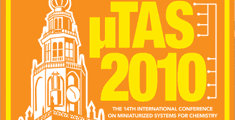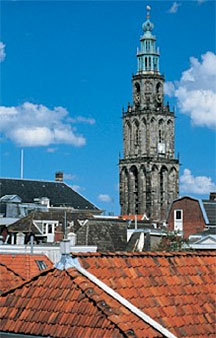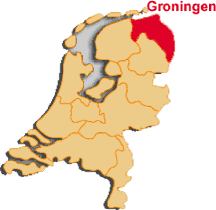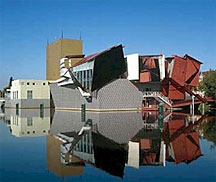  | ||||
|
About Groningen Conference Map Groningen Information Things to Do |
 The city of Groningen is the capital of the province of Groningen, the north easternmost province of the Netherlands. The largest (185,000 people) urban center in the area, it is a relatively undiscovered and unspoiled part of the Netherlands that has kept most of its authenticity. Groningen has been awarded the title of Best City Center in the Netherlands. Groningen is an attractive city with a level of facilities that can only be found in major cities. Institutions such as the University, the University Medical Centre, the headquartes of N.V. Nederlandse Gasunie and the Groninger Museum, make Groningen the regional centre for more than half a million people.
The center of Groningen has been preserved and its attraction lies in a contrast between old and new Groningen. Founded in the third century, it has one of the oldest universities (1614) in the Netherlands. Its status as a major Dutch educational center has imbued Groningen with a vibrant arts scene, lively nightlife and a wealth of fascinating museums covering various topics from science to comics, and even tobacco.
The city of Groningen is the capital of the province of Groningen, the north easternmost province of the Netherlands. The largest (185,000 people) urban center in the area, it is a relatively undiscovered and unspoiled part of the Netherlands that has kept most of its authenticity. Groningen has been awarded the title of Best City Center in the Netherlands. Groningen is an attractive city with a level of facilities that can only be found in major cities. Institutions such as the University, the University Medical Centre, the headquartes of N.V. Nederlandse Gasunie and the Groninger Museum, make Groningen the regional centre for more than half a million people.
The center of Groningen has been preserved and its attraction lies in a contrast between old and new Groningen. Founded in the third century, it has one of the oldest universities (1614) in the Netherlands. Its status as a major Dutch educational center has imbued Groningen with a vibrant arts scene, lively nightlife and a wealth of fascinating museums covering various topics from science to comics, and even tobacco.Groningen's main attractions are its two beautifully designed central squares: the 15th century Martinikerk and the Renaissance Goudkantoor in the Grote Markt. Cars are banned from the picturesque historic centre. Part of this area was destroyed during WWII; however, many of the medieval and 16th and 17th century structures survived. The University of Groningen was founded in 1614 and its student population keeps the city vibrant.  It is easy to feel 'at home' in Groningen. The city centre has no fewer than 160 bars, cafés and discotheques, and scores of open-air terraces on which to enjoy a balmy summer evening. There is something for everyone - from the traditional Dutch 'brown café' to the trendiest hi-tech. And because Groningen is the 'youngest' city in the Netherlands (over half the population are under thirty-five) these bars are not only lively at weekends, but on weekdays as well. Of course, the city centre is not all bars and cafés. It is also a district in which people live, work, shop and soak up a lot of culture. It is rich in history and offers plenty for the visitor to see.
It is easy to feel 'at home' in Groningen. The city centre has no fewer than 160 bars, cafés and discotheques, and scores of open-air terraces on which to enjoy a balmy summer evening. There is something for everyone - from the traditional Dutch 'brown café' to the trendiest hi-tech. And because Groningen is the 'youngest' city in the Netherlands (over half the population are under thirty-five) these bars are not only lively at weekends, but on weekdays as well. Of course, the city centre is not all bars and cafés. It is also a district in which people live, work, shop and soak up a lot of culture. It is rich in history and offers plenty for the visitor to see.The city's landmark is the Martini tower which has overlooked the city for over 500 years. Visitors can climb this fourth-highest tower of the Netherlands up to the third gallery to get a spectacular view across the city. Adjoining the tower is the Martini church, largest in Groningen. It originates from approximately 1230 AD and contains frescos from the 13th century and one of the largest Baroque organs in northwest Europe. Two main attractions are the beautifully designed central squares: Martinikerk and the Renaissance Goudkantoor in the Grote Markt.  Art pervades the city, even in the train station with its magnificent stained glass windows. The Groningen Museum, designed by the Italian architect Alessando Mendini, is opposite the train station and houses a permanent collection of 17th-century works (including Rubens' Adoration of the Magi), Hague School paintings, ceramics, modern art, archeological artifacts as well as works by Groningen's expressionist De Ploeg group. Surrounded by water, the museum looks like a sea-going vessel. Groningen has a considerable amount of modern architecture that goes hand in hand with historic architecture. There is an Italian link, proven by the fact that many of the most remarkable buildings in the city were designed by Italians.
Art pervades the city, even in the train station with its magnificent stained glass windows. The Groningen Museum, designed by the Italian architect Alessando Mendini, is opposite the train station and houses a permanent collection of 17th-century works (including Rubens' Adoration of the Magi), Hague School paintings, ceramics, modern art, archeological artifacts as well as works by Groningen's expressionist De Ploeg group. Surrounded by water, the museum looks like a sea-going vessel. Groningen has a considerable amount of modern architecture that goes hand in hand with historic architecture. There is an Italian link, proven by the fact that many of the most remarkable buildings in the city were designed by Italians.There are numerous walking (self and guided) and guided bike tours that are offered by the Tourist Office (info@vvvgroningen.nl). One can concentrate on art walks, architecture walks, culinary walks, and art exhibition walks among others. There are numerous galleries to visit as well. Bicycles are easy to rent and Groningen has been called the world's Best City for Cycling. For more information, visit www.paulienexcursions.nl or www.culinairwandelen.com.  Groningen was once bordered by a canal. Currently, there are houses, old warehouses, offices, and works of art on both sides of the canal and guided canal walks are available. For more information, visit www.grachtenwandeling.nl. If one prefers to explore Groningen from the water, there are several options including a guided boat tour on the canal or a do-it-yourself canoe trip. The 't Peddeltje canoe hire is located under the Herebrug bridge; pedal boats are also for hire here.
Groningen was once bordered by a canal. Currently, there are houses, old warehouses, offices, and works of art on both sides of the canal and guided canal walks are available. For more information, visit www.grachtenwandeling.nl. If one prefers to explore Groningen from the water, there are several options including a guided boat tour on the canal or a do-it-yourself canoe trip. The 't Peddeltje canoe hire is located under the Herebrug bridge; pedal boats are also for hire here.Other museums in Groningen include the Dutch Comic Strip Museum, Nautical Museum, Tobacco Museum, Graphic Arts Museum, and the University with its extensive collection of instruments and objects used at the University of Groningen, including material for medicine, biology, physics, and psychology. The collection also includes minerals and fossils, in addition to prints and costumes. The Prinsenhoftuin Garden, which includes a rose garden and an herb garden, is one of the best examples of a Renaissance garden in the Netherlands. It is open from early April through mid-October. Established in the 17th century, Hortus Haren has many interesting attractions. Coffee bushes, cinnamon trees, vanilla orchids and bananas flourish in this tropical rainforest environment. Get close to the collection of tropical insects in the insectarium or relax in the Chinese garden, a replica of a Chinese Mandarin's Feng Shui garden from the Ming Dynasty. Since the Groningen World Exhibition in 1903, Groningen has remained a festival city, whether for sports, pop music, jazz, blues, classical music, film, or theatre. Groningen also has a variety of restaurants (some with a Michelin star), cafes, and pubs with a special character. Many of the cafes and pubs of the city are located in the Ellebogenburt district on the south side of the Grote Markt. This complex is the largest beer serving point in the Netherlands. You can have a drink and listen to live music or simply enjoy the atmosphere. Groningen's entertainment has no fixed closing hour, ensuring a bustling nightlife both during the week as well as on weekends. |
|||